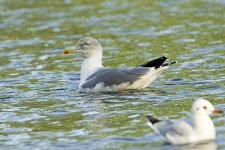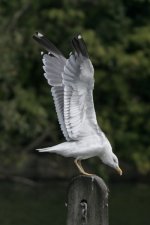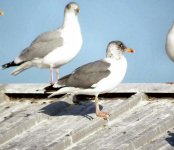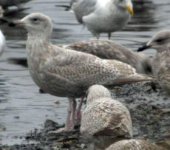Oh, Jan. I wish you hadn't asked. Per previous posts, I don't really do gulls yet, I still have easier IDs to master (spent two hours yesterday in the company of Willow and Marsh Tits) Olsen and Larsen is coming for Christmas, and Collins doesn't cut it, but let's see, for entertainment's sake, how I'm coming along:
Age: The bird is full adult (which is a great starter!)
Mantle: Slate grey or darker (and the comments say darker), suggest intermedius rather than graellsi if the bird is LBBG. Too dark for argenteus, argentatus, michahellis, and apparently cachinnans (which I have not seen) and may be consistent with other LWHG taxa I don't know.
Head Streaking: Too extensive for michahellis, too dark for Herring taxa, is heavy, dark and extends in front of eye which is not classic for graellsi or intermedius?
Legs: Presumably yellow, hence YLG identification, but not shown in this photo. If they were now pinkish would Chris not have noted this?
Bill: Red spot limited to lower mandible consistent with all but michahellis of familiar taxa, but this is not a very reliable feature? Gonydeal angle criteria not understood by me. Ditto forehead angle which from one photo is consistent with all familiar taxa?
Primary Tips/Windows: Appear too small for Herring, and possibly too large for LBBG. Best fit seems to be YLG?
Eye: No clear orbital ring would suggest LBBG rather than YLG or Herring?
Conclusion: LWHG viewed singly on computer monitor appears to show (from photos and accounts) features which are not universally consistent with any familiar taxa occuring with greatest frequency in UK. (graellsi, intermedius, argenteus, argentatus, michahellis, marinus, glaucoides, hyperboreus) Neither does it fit, based on my limited literature, fuscus, armenicus, cachinnans, heuglini.
Conclusion 2: It's a Sea Gull. I don't know what kind.
What is it really and why? It's a lesser black-backed, isn't it Jan? Or you wouldn't have asked? :h?: :h?: :h?:
Graham








